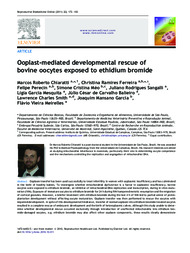Ooplast-mediated developmental rescue of bovine oocytes exposed to ethidium bromide.
Ooplast-mediated developmental rescue of bovine oocytes exposed to ethidium bromide.
Autoria: CHIARATTI, M. R.; FERREIRA, C. R.; PERECIN, F.; NICIURA, S. C. M.; SANGALLI, J. R.; MESQUITA, L. G.; BALIEIRO, J. C. de C.; SMITH, L. C.; GARCIA, J. M.; MEIRELLES, F. V.
Resumo: Ooplasm transfer has been used successfully to treat infertility in women with ooplasmic insufficiency and has culminated in the birth of healthy babies. To investigate whether mitochondrial dysfunction is a factor in ooplasmic insufficiency, bovine oocytes were exposed to ethidium bromide, an inhibitor of mitochondrial DNA replication and transcription, during in-vitro maturation (IVM). Exposure of immature oocytes to ethidium bromide for 24?h during IVM hampered meiotic resumption and the migration of cortical granules. However, a briefer treatment with ethidium bromide during the last 4?h of IVM led to partial arrest of preimplantation development without affecting oocyte maturation. Ooplasm transfer was then performed to rescue the oocytes with impaired development. In spite of this developmental hindrance, transfer of normal ooplasm into ethidium bromide-treated oocytes resulted in a complete rescue of embryonic development and the birth of heteroplasmic calves. Although this study unable to determine whether developmental rescue occurred exclusively through introduction of unaffected mitochondria into ethidium bromide-damaged oocytes, e.g. ethidium bromide may also affect other ooplasm components, these results clearly demonstrate that ooplasm transfer can completely rescue developmentally compromised oocytes, supporting the potential use of ooplasm transfer in therapeutic applications. Although the transfer of egg cytoplasm between women has been used successfully to rescue development in infertile patients culminating in the birth of healthy babies, the aetiology of egg-related infertility remains poorly understood. To verify the role played by a dysfunction in the mitochondrial activity, bovine eggs were exposed to ethidium bromide, a drug commonly used to impair mitochondrial function. We show that eggs exposed to ethidium bromide arrest embryonic development after IVF. Moreover, a complete rescue of development was observed after transfer of cytoplasm from untreated eggs into ethidium bromide-treated eggs leading to the birth of heteroplasmic calves which contained mitochondria from donor and recipient eggs (heteroplasmy). Although we were unable to confirm that mitochondria were the only ooplasm component affected by ethidium bromide, we provide evidence that cytoplasm transfer can completely rescue developmentally compromised oocytes.
Ano de publicação: 2011
Tipo de publicação: Artigo de periódico
Unidade: Embrapa Pecuária Sudeste
Palavras-chave: Embryo, Ethidium bromide, Oocyte, Ooplasm, Transfer, mitochondrial DNA
Observações
1 - Por padrão são exibidas publicações dos últimos 20 anos. Para encontrar publicações mais antigas, configure o filtro ano de publicação, colocando o ano a partir do qual você deseja encontrar publicações. O filtro está na coluna da esquerda na busca acima.
2 - Para ler algumas publicações da Embrapa (apenas as que estão em formato ePub), é necessário ter, no celular ou computador, um desses softwares gratuitos. Sistemas Android: Google Play Livros; IOS: iBooks; Windows e Linux: software Calibre.
Acesse outras publicações
Acesse a Base de Dados da Pesquisa Agropecuária (BDPA) para consultar o acervo completo das bibliotecas da Embrapa.

